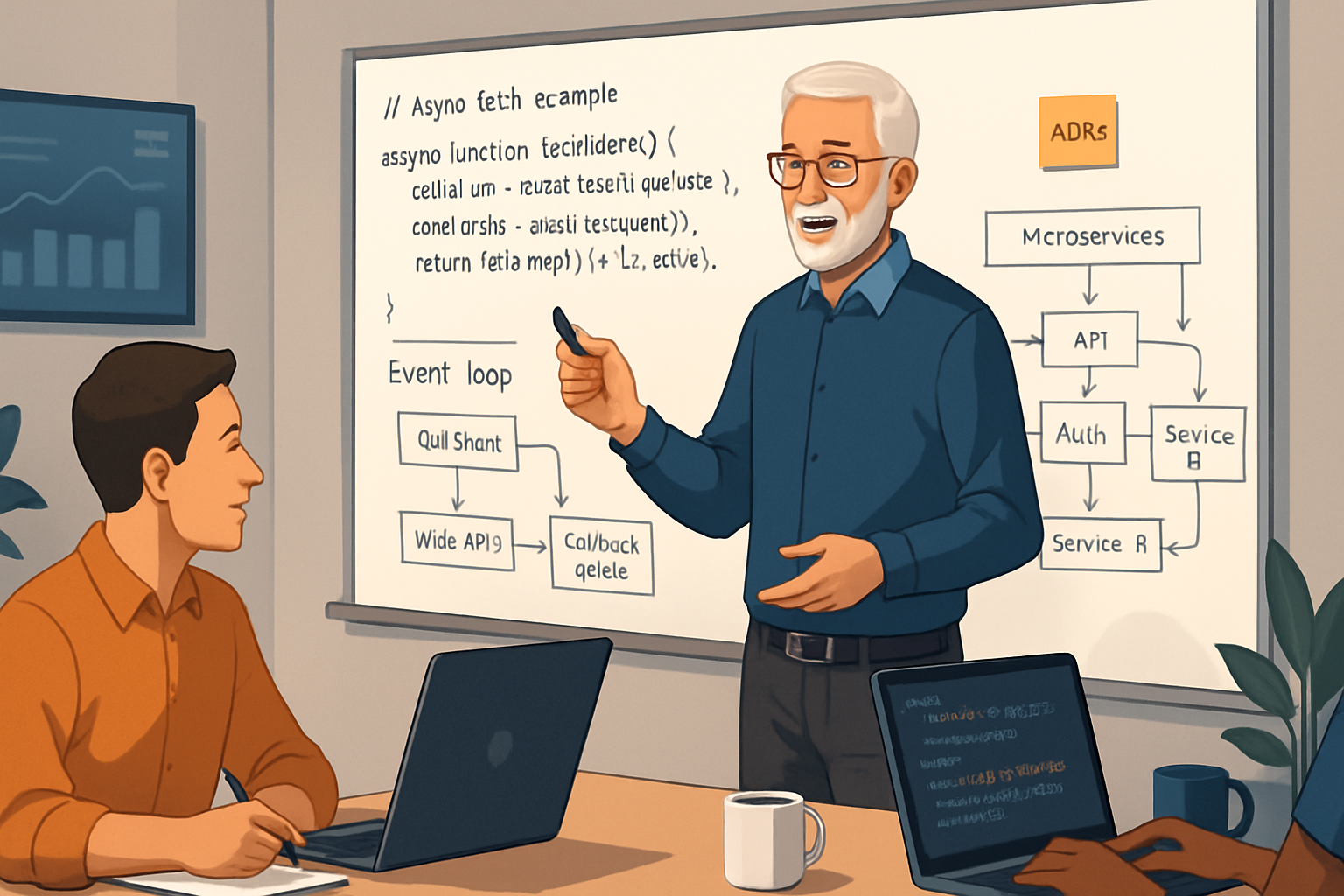· career · 7 min read
From Code to Leadership: Navigating the Transition from JavaScript Engineer to Engineering Manager
A practical guide for JavaScript engineers making the jump into engineering management. Learn the mindset shifts, core skills (emotional intelligence, communication, coaching), actionable first-90-day roadmap, meeting templates, feedback scripts, metrics, and recommended resources to succeed as an engineering manager.

Introduction
Moving from a JavaScript engineering role into engineering management is one of the most rewarding - and challenging - career transitions you can make. You swap ship-focused problem solving for navigating a fleet: instead of owning the code, you own the team that builds it. This post explains the mindset shift, the essential skills (with practical examples), and an actionable roadmap to help you thrive in your first months as a manager.
Why this transition is hard (and worth it)
- The metric changes: impact is no longer measured by features shipped or PRs closed but by the team’s outcomes - quality, velocity, developer growth, and product impact.
- Role change: you go from making individual technical decisions to enabling others to make great decisions and aligning those decisions with company goals.
- Different incentives: promotion criteria for managers are about influence, coaching, hiring, and strategic thinking rather than pure technical output.
If you want to multiply your impact and shape technical direction at a higher level, the trade-offs are worth it - but only if you intentionally develop the new skills required.
Mindset shifts: from doer to multiplier
- Measure success by the team’s outcomes, not your commits.
- Prioritize growing people over optimizing short-term delivery.
- Prefer enabling autonomy over micromanaging details.
- Embrace ambiguity: managers often make imperfect decisions quickly and iterate.
- Trade depth for breadth: you won’t know every technical corner anymore; learn enough to ask the right questions.
A practical corollary: stop solving every bug yourself. Your job becomes building processes, removing roadblocks, and ensuring the team has what it needs.
Core skills and how to practice them
1) Emotional intelligence (EQ)
Why it matters: EQ helps you read the room, manage conflict, coach effectively, and build trust.
What to practice:
- Self-awareness: keep a short daily or weekly reflection log. Note triggers and reactions.
- Self-regulation: pause before responding to heated messages; use a draft and re-read later.
- Empathy: practice active listening in 1:1s (ask open questions; paraphrase to confirm understanding).
Resources: Daniel Goleman’s work on emotional intelligence is a foundational starting point: https://www.danielgoleman.info/topics/emotional-intelligence/.
2) Effective team communication
Why it matters: managers translate strategic priorities into clear, aligned work.
Tactics:
- Run disciplined 1:1s (see template below).
- Prefer clarity and brevity in async updates; use summaries with action items.
- Create rituals: weekly syncs, triage, tech-review, and demo days to maintain shared context.
Example 1:1 agenda (30–45 min)
- Quick personal check-in (2–3 min)
- Wins and blockers (5–10 min)
- Career & growth conversation (10–15 min)
- Feedback exchange & action items (5–10 min)
- Recap + commitments (2 min)
3) Strategic decision-making
Managers must balance short-term delivery with long-term technical health.
Frameworks and heuristics:
- Cost/Benefit + Risk assessment for architecture choices (ask: how much will it save or accelerate, and what are the risks?)
- Timebox explorations (spikes) to validate assumptions.
- Use OKRs and outcome-driven measures rather than output metrics.
Recommended reading: Camille Fournier’s The Manager’s Path explains leadership stages and strategic thinking: https://www.oreilly.com/library/view/the-managers-path/9781491973899/.
4) Hiring, coaching, and developing people
Hiring well scales your team. Coaching multiplies individual performance.
Hiring best practices:
- Define role outcomes and core competencies before interviewing.
- Use consistent rubrics and structured interviews to reduce bias.
- Involve cross-functional interviewers and give timely feedback.
Coaching tools:
- Use the GROW model in career conversations (Goal, Reality, Options, Will) - overview: https://en.wikipedia.org/wiki/GROW_model.
- Feedback script: use SBI (Situation-Behavior-Impact) when giving direct feedback.
Example SBI feedback:
- Situation: “During yesterday’s sprint planning…”
- Behavior: “…you interrupted Sophia several times while she was explaining her estimate.”
- Impact: “That made it harder for her to share context and the team missed a potential risk.”
5) Technical stewardship (without micromanaging)
A manager should ensure sound technical direction while delegating implementation.
How to do it:
- Define and nurture an architecture vision.
- Set guardrails (coding standards, critical review pass/fail criteria) and escalation paths.
- Reserve technical deep-dives for systemic issues - trust engineers for routine design decisions.
Pitfall to avoid: treating code reviews as the only leverage point. They’re useful, but coaching and hiring are higher leverage.
Practical roadmap: before promotion, first 90 days, 6–12 months
Before promotion
- Practice influencing without authority: lead a small project, run retro improvements, mentor peers.
- Learn basic HR/compensation concepts and the promotion ladder at your company.
First 30 days (Discover & Build Trust)
- Meet the team, peers, and product/stakeholder partners.
- Run skip-level 1:1s where possible to understand culture.
- Listen more than you talk: ask about blocked projects, technical debt, and career goals.
- Quick wins: unblock at least one important issue for the team.
Day 30–60 (Diagnose & Act)
- Start improving rituals: make 1:1s regular, set meeting cadences, document processes.
- Map technical risks and backlog of debt; prioritize with stakeholders.
- Create initial success metrics with the team (quality, cycle time, deployment frequency, team sentiment).
Day 60–90 (Align & Scale)
- Run a team planning session with clear outcomes and measurable objectives.
- Hire for critical gaps or define growth plans for existing engineers.
- Introduce a development plan template and commit to quarterly growth checkpoints.
6–12 months
- Refine the team charter and longer term strategy.
- Improve recruiting funnel and interview experience.
- Institutionalize onboarding and mentorship programs.
- Regularly measure team health and iterate on processes.
Meetings, rituals, and docs that matter
- 1:1s (weekly or biweekly) - for coaching and career conversations.
- Weekly team sync - for tactical alignment.
- Sprint planning / PI planning - to set expectations.
- Retrospectives - for continuous improvement.
- Tech demo and architecture syncs - to maintain collective ownership.
- On-call blameless postmortems - to learn and improve reliability.
Document everything important: onboarding guides, RFC templates, decision records (ADR), and team playbooks. Async-first documentation prevents tribal knowledge.
Metrics: how to measure your impact
Focus on outcomes, not activity. Sample signals:
- Product outcomes: adoption, engagement, retention related to features you own.
- Delivery health: lead time, cycle time, deployment frequency, mean time to restore (MTTR).
- Quality: bug rate, escaped defects, code churn on core modules.
- Team health: engagement survey scores, attrition, promotion rate, time spent on unplanned work.
Use metrics as conversation starters, not as sole performance criteria.
Common pitfalls and how to avoid them
- Micromanaging: if you still touch every PR, you’re not scaling. Delegate and set guardrails.
- Avoiding tough conversations: address performance and conduct issues early with direct, compassionate feedback.
- Keeping meetings as the be-all: optimize meetings for outcomes and prefer async updates.
- Over-prioritizing features at the expense of the team’s growth or technical debt.
Quick templates and scripts
- Short feedback template (SBI + Next Step)
- Situation: “In our last retro…”
- Behavior: “…you spoke over two teammates while they were sharing.”
- Impact: “That reduced psychological safety and some voices were lost.”
- Next step: “Can we try to hold a space for others to finish before responding next retro? I’d be happy to help coach this behavior in one or two sessions.”
- Interview scorecard sections (example)
- Role fit and outcomes alignment
- Problem-solving and system design (JS runtime and system thinking)
- Code quality and testing approach
- Collaboration and communication
- Growth potential and learning habits
- 1:1 agenda (repeated for convenience)
- Personal check-in
- Wins & blockers
- Career & growth focus
- Feedback to/from manager
- Action items & commitments
Learning plan & resources
Books and guides
- The Manager’s Path - Camille Fournier (career stages & technical leadership): https://www.oreilly.com/library/view/the-managers-path/9781491973899/
- Radical Candor - Kim Scott (direct, human feedback & communication): https://www.radicalcandor.com/
- Emotional intelligence resources - Daniel Goleman: https://www.danielgoleman.info/topics/emotional-intelligence/
Handbooks and collections
- Engineering Manager Handbook (community resources and templates) - search or use well-curated repos and blogs for concrete templates.
Articles
- Use HBR and Manager Tools for frameworks on feedback, delegation, and meetings: https://www.manager-tools.com/
Learning routine
- Weekly: 1–2 hours of reading + reflection on management topics.
- Monthly: practice a management skill (e.g., running a retro, conducting a mock interview, delivering feedback).
- Quarterly: solicit peer feedback and update your leadership goals.
Closing: lead like a builder of people
Transitioning from JavaScript engineer to engineering manager means adopting a new identity: you become a builder of systems and people. The technical instincts that made you a great engineer remain valuable - they now guide coaching, architecture decisions, and risk assessment. The most effective managers pair technical judgment with high emotional intelligence, clear communication, and a strategic lens.
Start small, document and iterate on your processes, and treat your team’s growth as your highest-leverage responsibility. Over time, you’ll find that multiplying engineers, creating a psychologically safe culture, and making strategic trade-offs can be the most satisfying and impactful work of your career.
References
- The Manager’s Path - Camille Fournier: https://www.oreilly.com/library/view/the-managers-path/9781491973899/
- Radical Candor - Kim Scott: https://www.radicalcandor.com/
- Emotional Intelligence - Daniel Goleman: https://www.danielgoleman.info/topics/emotional-intelligence/
- GROW model (overview): https://en.wikipedia.org/wiki/GROW_model
- Manager Tools: https://www.manager-tools.com/



